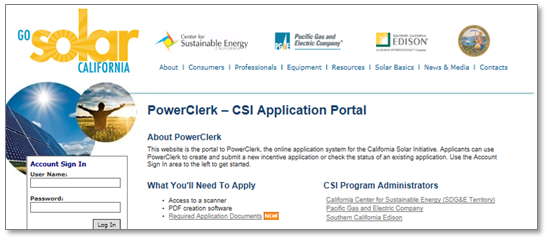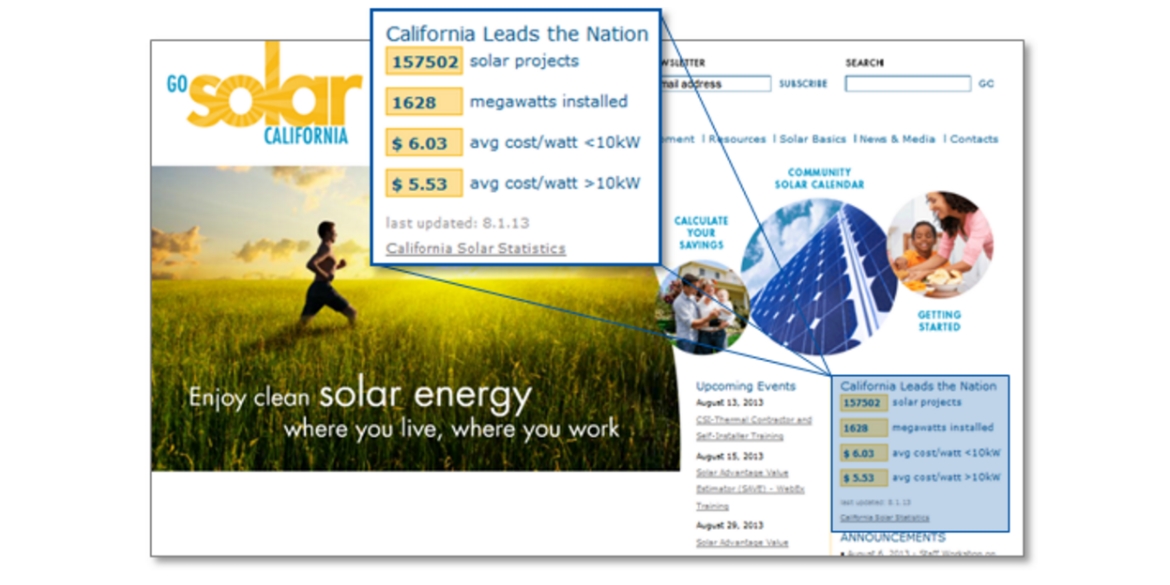It’s a remarkable achievement that in just seven years, the California Solar Initiative (CSI) has reported an estimated 1,629 megawatts (MW) of solar PV has been committed. That is a whopping 85% of its goal to install 1,940 MW of solar by the end of 2016 in California’s independently owned utilities (IOUs)—Pacific Gas and Electric (PG&E), Southern California Edison (SCE), and San Diego Gas and Electric (SDG&E). That figure includes both installed projects, as well as projects for which incentives have been reserved, but not yet paid out, pending installation.
To help put these numbers into perspective, the 1,629 MW of solar capacity is:
- Installed at 167,878 customer sites within the PG&E, SCE and SDG&E service territories.
- Enough to power approximately 150,000 homes and avoid building three power plants.
Helping the CSI towards its goal were strong growth numbers in 2012. Within the IOU territories, there were 38,436 solar projects installed, a growth of 40% from 2011.
It’s been nearly a decade since Governor Arnold Schwarzenegger set forth his Million Solar Roofs vision for California. In support of that vision, he signed Senate Bill 1 into law, which directed the California Public Utilities Commission (CPUC) and the California Energy Commission (CEC) to implement the CSI program, beginning in January 2007. At that time, the CSI was the boldest effort in the country and one of the boldest efforts in the world to support and grow the solar industry.
The CSI realized early-on that such a bold vision would require bold actions to both design a sustainable program, and implement tools to manage such a large incentive program.
Here at Clean Power Research, we are very proud of our long affiliation with the CSI program. We were involved in the early work on incentive design, which included logical incentive step-downs. These step-downs, which reduced incentive amounts over time based on install rates, allowed the solar industry in California to grow without overheating and abruptly shutting down like other solar programs around the world. The program has been very successful, with installation rates continuing to climb even as incentives decrease.
In addition, knowing that the program would require processing of tens of thousands of incentive applications, the CSI brought the entire process online with our PowerClerk® Incentives software service. PowerClerk has allowed the program to grow without burying the IOU administrators in paper and requiring an army of people to administer. Installers also appreciate having a simple-to-use, online application system that is consistent from one IOU territory to another, saving them time and money.

PowerClerk has also served as a valuable repository of information about installed PV systems—everything from installation date, cost and location—to system specifications such as make and manufacturer of panels and inverters; direction and tilt; and shading. That information is used to calculate incentive amounts for each application. The CSI also pulls the information from PowerClerk to generate the CSI Solar Statistics that are published each week. This data is invaluable to the market, and makes it possible to show trends over time, such as the 32% decline in the average cost of residential systems from 2007 to the first quarter of 2013.
The specifications stored in PowerClerk have also proven valuable to utilities and balancing area authorities by enabling them to analyze the impact of distributed PV on their operations. Imagine being able to forecast the production of all 167,878 PV systems for the next hour, five hours, or even several days ahead? Because the location and specifications of all the systems installed in California’s IOU territories, that is possible today.
Although the CSI incentives in the SDG&E territory residential territory are exhausted, and PG&E’s are nearly exhausted, the solar industry in California is vibrant and growing. This could not have happened without well designed programs and scalable tools. The data CSI has made available to the public has also proven invaluable to long-term growth—both in helping the finance community to get comfortable with solar, as well as providing the utility operators the information they need to reliably integrate high penetration PV.
